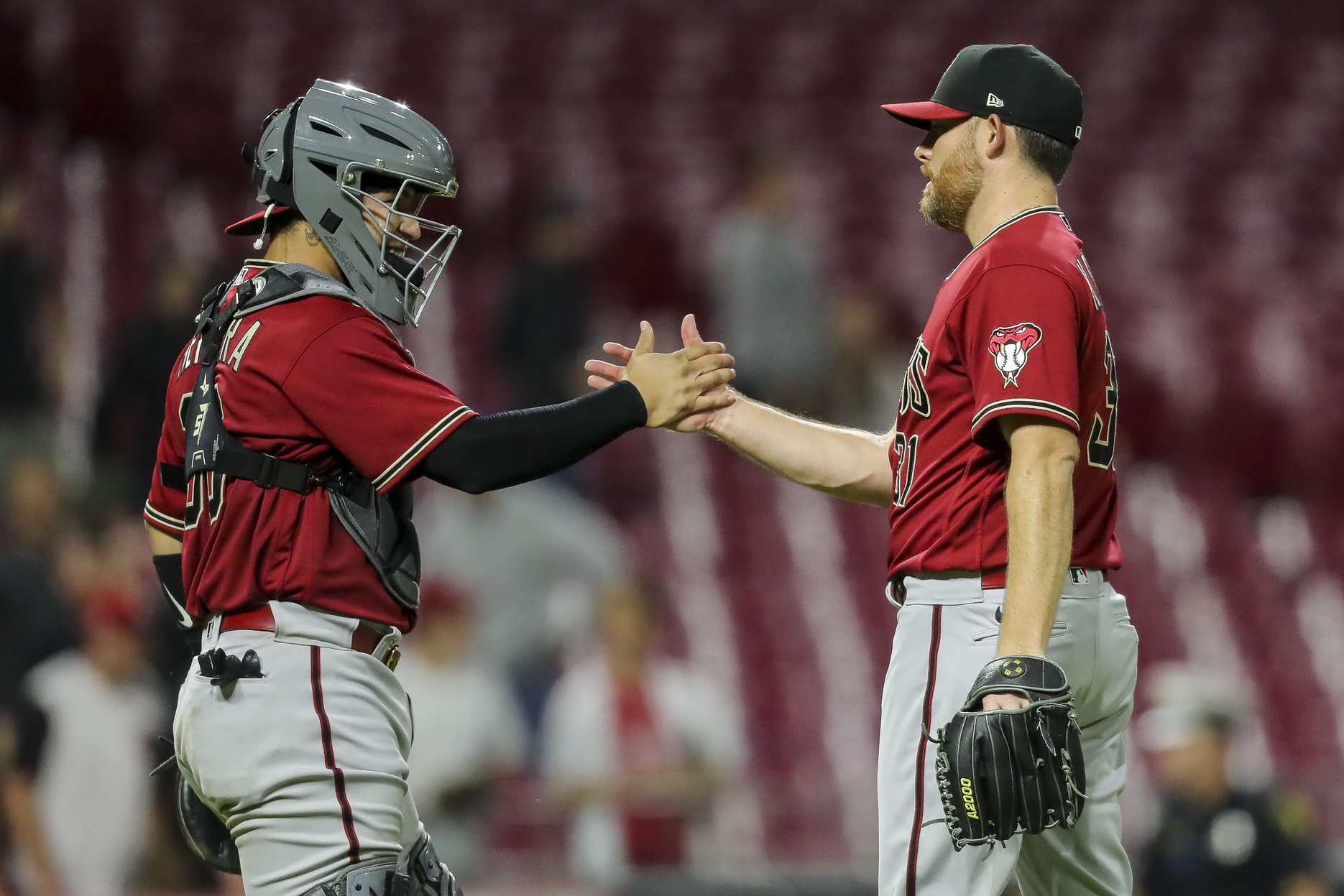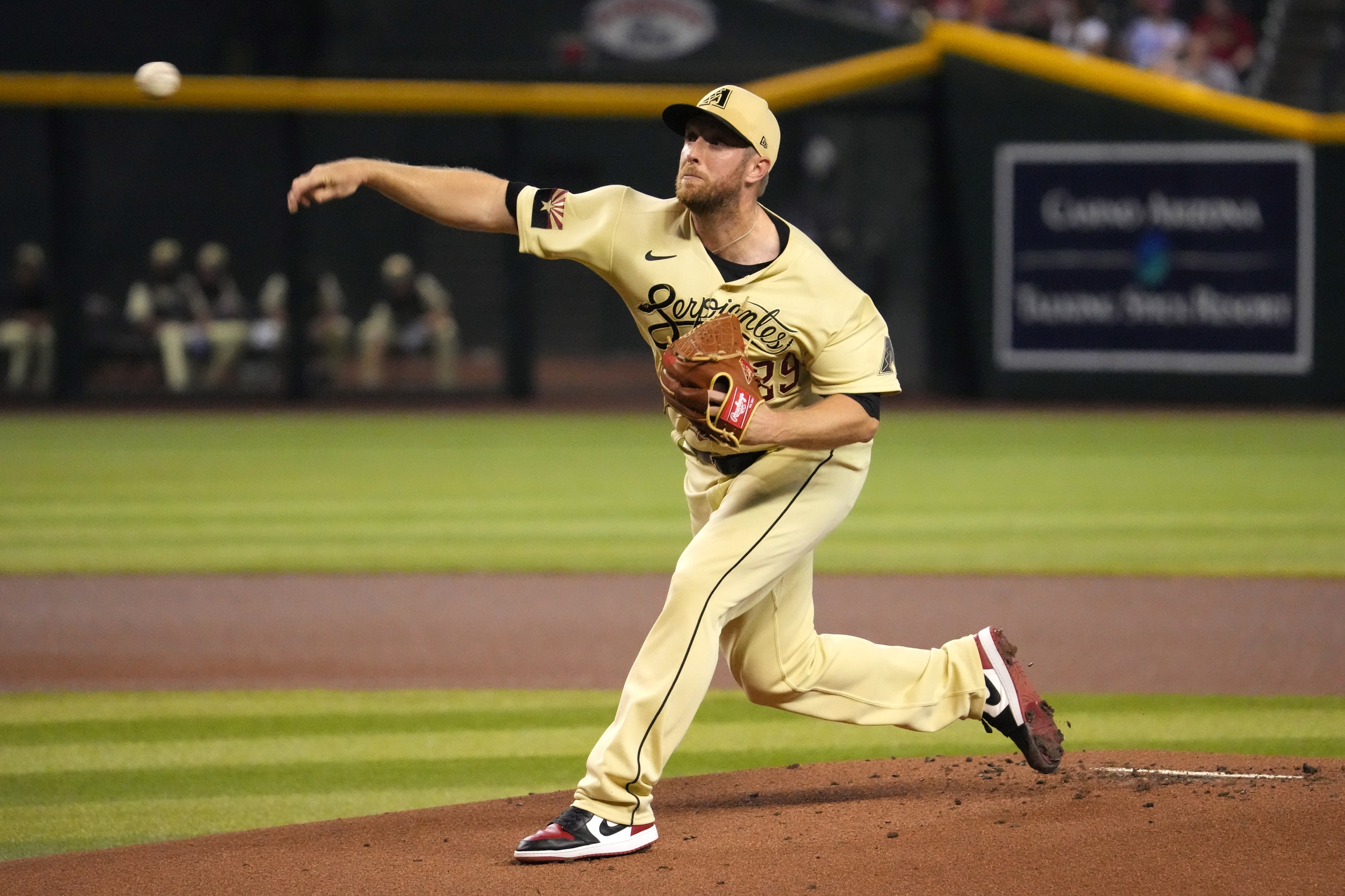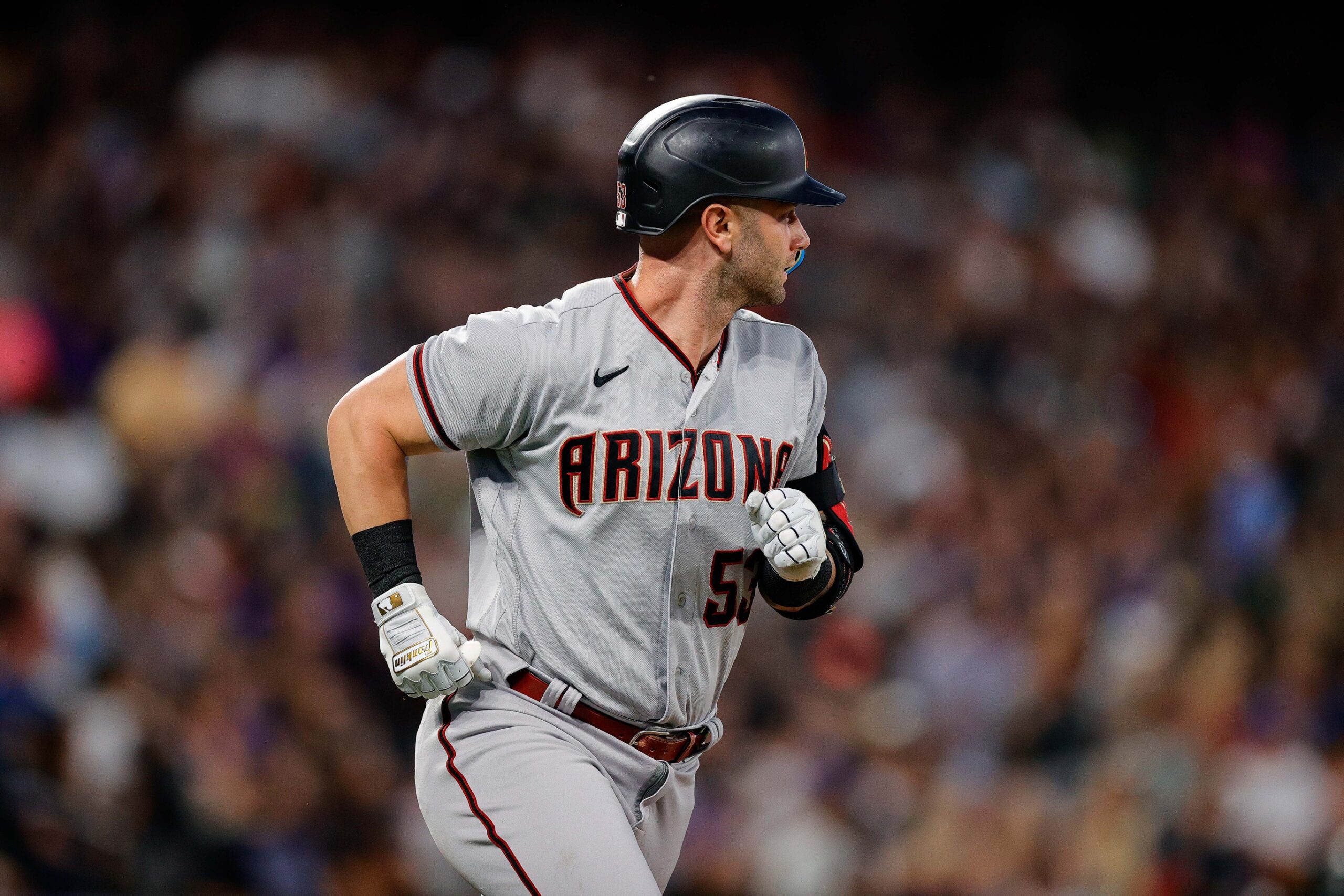© 2025 ALLCITY Network Inc.
All rights reserved.

The calendar has turned to July, and the MLB trade deadline on Aug. 2 (two days later than normal due to the lockout) is now less than a month away.
Two weeks ago, Diamondbacks general manager Mike Hazen was not ready to commit to a course at the trade deadline.
“The team is going to dictate how we’re kind of looking at things,” Hazen told reporters on June 14. “I want to win as many games as possible. I want to compete until the end of the season for a playoff spot.”
Coming off a 9-16 record in June, the Diamondbacks are 35-43. Although the team is much improved from last season, winning the division was never a realistic aspiration, and the Padres, Giants, Cardinals, Braves and Phillies are all eight or more games ahead in a wild card race that only has three winners.
With playoff hopes shrinking, the Diamondbacks will likely play the role of seller at the trade deadline (though Hazen is all but certain to avoid the use of that word). In addition, several long-term assets also figure to draw interest, and Hazen could take steps to resolve a roster log-jam that is fast approaching.
There’s a lot to sort through here. To start, here are five players (plus a few honorable mentions) who are most likely to be moved.
Who is most likely to be dealt?

1. David Peralta, OF | Likelihood: High
Despite David Peralta’s popularity among Diamondbacks fans, there’s no escaping the fact that the Freight Train may be off the desert tracks soon.
In 68 games, Peralta is slashing .247/.315/.462 with 10 homers, 31 RBI, 16 doubles and a triple. His .215 ISO — a measure of raw power — is the second-highest mark of his career, and he is on pace for his first 20-plus homer season since 2018.
At the heart of Peralta’s newfound power is a dramatic drop-off in ground-ball rate.
Peralta is in the last year of a three-year, $22 million extension he signed in early 2020, and he is due to make around $4 million the rest of the year. His veteran leadership, reliable left-handed bat and well-regarded defense could prove valuable for a contender.
Moreover, the Diamondbacks are loaded with left-handed hitting outfielders such as Alek Thomas, Daulton Varsho, Josh Rojas and the recently demoted Pavin Smith.
Dealing Peralta before the deadline could also open the door down the stretch for minor-leaguers such as Jake McCarthy, Stone Garrett, Dominic Fletcher and Dominic Canzone, who are currently blocked on the outfield depth chart.

2. Ian Kennedy, RP | Likelihood: High
With a 1.54 WHIP and an opponent batting line of .266/.341/.431, it hasn’t always been pretty for Diamondbacks setup man Ian Kennedy this season. His strikeout rate of 20.2 percent is down seven points from last year, and his walk rate of 10.5 percent is up three percent.
Nonetheless, the D-backs righty has found his way to a respectable 3.62 ERA, in large part because opposing hitters are just 7-for-30 against him with runners in scoring position. All seven of those hits are singles.
Whether or not Kennedy’s success is sustainable remains to be seen, but he could be a useful middle reliever for a contender.
Kennedy has about $2.25 million left on his deal this year plus possible bonuses, as well as a $4 million club option for 2023 with a $250,000 buyout.
Given Kennedy’s unsightly peripheral numbers and the fact that he’s almost 38, he’s not likely to net much in a trade. Nonetheless, Hazen has dealt relievers from a similar position in the past, most recently when he traded Joakim Soria last year.

3. Zach Davies, SP | Likelihood: Medium
After posting a 5.78 ERA with the Cubs last year, Zach Davies has bounced back nicely for the Diamondbacks in 2022 to the tune of a 3.94 ERA, 1.20 WHIP and a significantly reduced walk rate of 7.8 percent.
He has benefitted from his opponents’ .259 BABIP and his strikeout rate is still relatively low at 18.7 percent, but he looks a lot more like the reliable No. 4 or No. 5 starter he’s been in the past.
Davies has roughly $750,000 plus performance bonuses remaining on his contract for 2022. Contenders will almost certainly jump at the chance to acquire a backend starter who comes so cheaply.
Given that Davies isn’t likely to exercise his 2023 mutual option, the Diamondbacks will probably lose him at the end of the season.
The main obstacle is that moving Davies means finding another starter to replace him. Theoretically, that shouldn’t be a problem since the Diamondbacks have several minor-league arms who could get the call to the big leagues soon. The list of possibilities includes Tyler Gilbert, Tommy Henry, Corbin Martin, Ryne Nelson, Drey Jameson, Bryce Jarvis, Brandon Pfaadt, Slade Cecconi, Dan Straily and others.
The other obstacle in dealing Davies — and probably the more important one — is that he recently landed on the 15-day injured list with right shoulder inflammation. Any deal hinges on him making a relatively quick recovery.

4. Merrill Kelly, SP | Likelihood: Low
Yes, Merrill Kelly did just sign a two-year contract extension in April, and it’s in large part for that reason he’s going to draw significant interest on the trade market.
Kelly has a 3.46 ERA and 1.26 WHIP in 91 innings over 16 starts in 2022, and there is a case to be made that he is the most deserving All-Star candidate on his team. Following his strong outing at Coors Field on Friday, Kelly is now 14th among National League pitchers in fWAR.
Under his new extension, Kelly is due to make $8 million in both 2023 and 2024 with a $7 million club option for 2025.
He’s the type of pitcher every team wants — including the Diamondbacks. As of now, Kelly figures to be a big part of the starting rotation as the team continues its ascent back into contention.
Nonetheless, it’s not impossible that Hazen and his staff could be overwhelmed by an offer before the deadline. If that happens, maybe he’s donning a different uniform come August.

5. Christian Walker, 1B | Likelihood: Low
His .206/.312/.487 batting line doesn’t show it, but Christian Walker is quietly having a breakout season. His success is still being masked by a .182 BABIP, which is the lowest in baseball among qualified players.
Nonetheless, Walker’s .400 xwOBA is far and away the highest mark of his career since he became an everyday player in 2019. He is on pace for 44 homers, and he is the early favorite for the NL Gold Glove award at first base.
Given the struggles of Smith, the Diamondbacks seem unlikely to deal Walker, who is arbitration eligible through 2024.
Nonetheless, he is sure to draw interest as a right-handed power hitter who is under team control for two more seasons after this one.

6. A plethora of other relievers
It’s probably safe to say there will be interest in other Diamondbacks relievers such as Kyle Nelson, Joe Mantiply and Noé Ramirez.
Mantiply, in particular, is having a breakout season with a 1.24 ERA, 0.86 WHIP, 26.4 percent strikeout rate and 57.1 percent ground-ball rate. Nonetheless, he is under team control through 2026 and has a relatively small track record of success.
The D-backs have had very few relievers who were both controllable and effective over the last decade, and they need more to stabilize their bullpen in the long-term. Mantiply could be a big part of that. For the moment, he probably has more value on the roster than as a trade chip.
The same could be said for Nelson, who has a 1.82 ERA and 1.09 WHIP over 24.2 innings. Again, Nelson’s track record is limited, and opposing teams likely won’t offer enough to justify moving him.
Speaking of track records, veteran closer Mark Melancon looked like a clear trade candidate when the team first acquired him, but it’s no secret he hasn’t lived up to his reputation so far in Arizona.
The D-backs likely would do better holding onto him and hoping he recoups some of his value. Melancon is due to make $6 million next year and has a $5 million mutual option for 2024.
The Diamondbacks’ roster space dilemma
When baseball fans think of selling at the trade deadline, they almost always envision trading away major-league players to get minor-league players in return. The Diamondbacks may do just that, but the team may need to venture off of that roadmap in order fix a lurking roster problem.
What is the problem? Well, the Diamondbacks have an army of minor-leaguers who are nearly major-league ready, and finding room for them will be no small task.
Not only is the active roster capped at 26 players (28 starting on Sep. 1), but most of the team’s up-and-coming players are not yet on the 40-man roster. Somehow, the Diamondbacks will have to clear that space. How much space?
Here is a list of every player who could command a 40-man roster spot in the next year — either because the team promotes them to the big leagues or because the team wants to protect them from this winter’s Rule-5 draft.
| Player | Current Level | 2022 Rule-5 Draft Eligible? |
| Josh Green, RHP | AAA | Y |
| Mitchell Stumpo, RHP | AAA | Y |
| Ryne Nelson, RHP | AAA | Y |
| Drey Jameson, RHP | AAA | Y |
| Tommy Henry, LHP | AAA | Y |
| Dominic Fletcher, OF | AAA | Y |
| Stone Garrett, OF | AAA | Y |
| Dominic Canzone, OF | AAA | Y |
| Matt Tabor, RHP | AA | Y |
| Blaze Alexander, SS | AA | Y |
| Brandon Pfaadt, RHP | AA | N (Eligible in 2023) |
| Slade Cecconi, RHP | AA | N (Eligible in 2023) |
| Blake Walston, RHP | AA | N (Eligible in 2023) |
| Bryce Jarvis, RHP | AA | N (Eligible in 2023) |
| Corbin Carroll, OF | AA | N (Eligible in 2023) |
Finding room for three players? Easy. Finding room for 15? Yikes.
Of course, Bryce Jarvis may not be ready for the majors in the next year. And maybe the Diamondbacks are willing to bet that opposing teams won’t target Mitchell Stumpo in the Rule-5 draft should the D-backs opt not to protect him.
But there is no getting around the fact that a sizable roster traffic jam is on the horizon, and ensuring the team’s minor-league talent isn’t stalled by it will be a challenge.
So, what does all this mean for the trade deadline?
First, the Diamondbacks may be more open to trading the aforementioned veterans than they otherwise would be. Maybe the return for a reliever isn’t all that inspiring, but they do it anyway so they can clear roster space.
Second, as counterintuitive as it sounds, the Diamondbacks may need to trade some of their minor-league talent (or even some of their young major-leaguers) in exchange for lower level minor-league talent.
Moving a young outfielder, in particular, could make a lot of sense. The Diamondbacks simply do not have the ability to give Thomas, Varsho, Smith, McCarthy, Canzone, Fletcher, Garrett, Corbin Carroll and Cooper Hummel the opportunities that they need to continue to develop.
By making a trade, the team could consolidate its outfield depth while also filling other needs in the organization.
What will the Diamondbacks target in return?
With the roster logjam in mind, it is immediately apparent that the Diamondbacks are unlikely to target players who are major-league ready. Bringing in high-ceiling players who are still at the lower levels of the minors is more likely.
From an organizational depth standpoint, that makes the most sense anyway. Despite having one of the top five or 10 farm systems in baseball for several years, the majority of the Diamondbacks’ minor-league talent is in the upper levels of the minors.
Outside of 2021 first-round pick Jordan Lawlar and perhaps a handful of others, the team’s rookie league and Single-A rosters lack high-ceiling talent. Adding depth in that regard figures to be a priority in any trade.
From a positional standpoint, the D-backs have focused on slim, defense-minded position players with many of their recent high-end draft picks, leaving the organization with a lack of raw power. They could use a few more prototypical clean-up hitter types, particularly at the infield corners.
Of course, you can never have too much pitching, so expect that to be a point of emphasis as well.
For a team that will likely do more selling than buying and has no superstars to dangle, the Diamondbacks’ trade deadline figures to be surprisingly fascinating. On paper, they could be one of the more active teams in the sport.
Follow Jesse Friedman on Twitter
Top photo: Rob Schumacher/The Republic
Get Arizona's Best Sports Content In Your Inbox!Become a smarter Arizona sports fan with the latest game recaps, analysis and exclusive content from PHNX's writers and podcasters!
Just drop your email below!
Comments
Share your thoughts
Join the conversation



